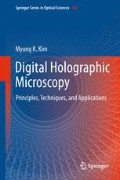Abstract
The intensity distribution on a hologram contains four terms
Of these, normally only one of the last two terms yields the desired holographic image, while the other terms – the zero-order and twin-image terms – only contribute to blurring and interference of the image. This is especially true in in-line configurations where all four terms are superposed on top of each other, but even in off-axis configurations they can limit the number of usable pixels and cause degradation of images. It is therefore a major consideration in any holography system design and there have been developed a fairly large number of techniques addressing the “dc and twin-image problem.” Some of these remove the DC term only, while others can suppress the twin image as well.
Access this chapter
Tax calculation will be finalised at checkout
Purchases are for personal use only
References
T. M. Kreis, and W. P. O. Juptner, “Suppression of the dc term in digital holography,” Optical Engineering 36, 2357–2360 (1997).
G. L. Chen, C. Y. Lin, M. K. Kuo, and C. C. Chang, “Numerical suppression of zero-order image in digital holography,” Optics Express 15, 8851–8856 (2007).
W. L. Bragg, and G. L. Rogers, “Elimination of the Unwanted Image in Diffraction Microscopy,” Nature 167, 190–191 (1951).
Y. Takaki, H. Kawai, and H. Ohzu, “Hybrid holographic microscopy free of conjugate and zero-order images,” Applied Optics 38, 4990–4996 (1999).
Y. M. Zhang, Q. N. Lu, and B. Z. Ge, “Elimination of zero-order diffraction in digital off-axis holography,” Optics Communications 240, 261–267 (2004).
J. A. H. Ramirez, and J. Garcia-Sucerquia, “Digital off-axis holography without zero-order diffraction via phase manipulation,” Optics Communications 277, 259–263 (2007).
N. Demoli, J. Mestrovic, and I. Sovic, “Subtraction digital holography,” Applied Optics 42, 798–804 (2003).
D. S. Monaghan, D. P. Kelly, N. Pandey, and B. M. Hennelly, “Twin removal in digital holography using diffuse illumination,” Optics Letters 34, 3610–3612 (2009).
E. Cuche, P. Marquet, and C. Depeursinge, “Spatial filtering for zero-order and twin-image elimination in digital off-axis holography,” Applied Optics 39, 4070–4075 (2000).
F. Le Clerc, L. Collot, and M. Gross, “Numerical heterodyne holography with two-dimensional photodetector arrays,” Optics Letters 25, 716–718 (2000).
J. W. Weng, J. G. Zhong, and C. Y. Hu, “Automatic spatial filtering to obtain the virtual image term in digital holographic microscopy,” Applied Optics 49, 189–195 (2010).
L. Xu, J. M. Miao, and A. Asundi, “Properties of digital holography based on in-line configuration,” Opt. Eng. 39, 3214–3219 (2000).
N. Pavillon, C. S. Seelamantula, J. Kuhn, M. Unser, and C. Depeursinge, “Suppression of the zero-order term in off-axis digital holography through nonlinear filtering,” Applied Optics 48, H186-H195 (2009).
Author information
Authors and Affiliations
Corresponding author
Rights and permissions
Copyright information
© 2011 Springer Science+Business Media, LLC
About this chapter
Cite this chapter
Kim, M.K. (2011). Suppression of DC and Twin-Image Terms. In: Digital Holographic Microscopy. Springer Series in Optical Sciences, vol 162. Springer, New York, NY. https://doi.org/10.1007/978-1-4419-7793-9_7
Download citation
DOI: https://doi.org/10.1007/978-1-4419-7793-9_7
Published:
Publisher Name: Springer, New York, NY
Print ISBN: 978-1-4419-7792-2
Online ISBN: 978-1-4419-7793-9
eBook Packages: Physics and AstronomyPhysics and Astronomy (R0)

